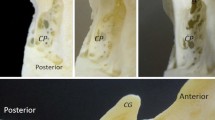Abstract
Purpose
A curvilinear pathway intervening between the olfactory fossa and nasal vestibule has not been well documented. Therefore, the aim of this study was to examine its structure using magnetic resonance imaging (MRI).
Methods
In total, 84 patients underwent thin-sliced, contrast MRI. Among these patients, 31 underwent additional thin-sliced, sagittal T2-weighted imaging.
Results
A curvilinear pathway intervening between the olfactory fossa and nasal vestibule was delineated on sagittal and coronal imaging in 98% and 82% of patients, respectively. All of these pathways demonstrated communication with the lower limit of the superior sagittal sinus (SSS) or fine venous channels connecting to the SSS in the vicinity of the crista galli. The pathway was identified in the parasagittal regions on both sides with varying lengths, diameters, and curvatures. In 94% of the patients who underwent sagittal T2-weighted imaging, the pathways appeared as linear high-intensity signals. Most pathways were delineated as a single channel coursing extracranially adjacent to the olfactory fossa. In 38% of the patients, post-contrast sagittal images showed variable filling defects between the olfactory bulb and floor of the olfactory fossa, furthermore traversing the venous pathway. Additionally, in 73% of the patients, post-contrast images identified diploic venous channels, variably in the nasal bone and communicating with the venous pathway.
Conclusions
A curvilinear pathway intervening between the olfactory fossa and nasal vestibule is a consistent venous structure and may function as an extracranial route of cerebrospinal fluid drainage.






Similar content being viewed by others
References
Dare AO, Balos LL, Grand W (2003) Neural–dural transition at the medial anterior cranial base: an anatomical and histological study with clinical applications. J Neurosurg 99:362–365
Erlich SS, McComb JG, Hyman S, Weiss MH (1986) Ultrastructural morphology of the olfactory pathway for cerebrospinal fluid drainage in the rabbit. J Neurosurg 64:466–473
Glück U, Gebbers JO (2000) The nose as bacterial reservoir: important differences between the vestibule and cavity. Laryngoscope 110:426–428
Gomez Galarce M, Yanez-Siller JC, Carrau RL, Montaser A, Lima LR, Servian D, Otto BA, Prevedello DM, Naudy CA (2018) Endonasal anatomy of the olfactory neural network: surgical implications. Laryngoscope 128:2473–2477
Jones AS, Crosher R, Wight RG, Lancer JM, Beckingham E (1987) The effect of local anaesthesia of the nasal vestibule on nasal sensation of airflow and nasal resistance. Clin Otolaryngol Allied Sci 12:461–464
Kida S, Pantazis A, Weller RO (1993) CSF drains directly from the subarachnoid space into nasal lymphatics in the rat. Anatomy, histology and immunological significance. Neuropathol Appl Neurobiol 19:480–488
Li C, Jiang J, Kim K, Otto BA, Farag AA, Cowart BJ, Pribitkin EA, Dalton P, Zhao K (2018) Nasal structural and aerodynamic features that may benefit normal olfactory sensitivity. Chem Senses 43:229–237
Murtha LA, Yang Q, Parsons MW, Levi CR, Beard DJ, Spratt NJ, McLeod DD (2014) Cerebrospinal fluid is drained primarily via the spinal canal and olfactory route in young and aged spontaneously hypertensive rats. Fluids Barriers CNS 11:12
Nagra G, Koh L, Zakharov A, Armstrong D, Johnston M (2006) Quantification of cerebrospinal fluid transport across the cribriform plate into lymphatics in rats. Am J Physiol Regul Integr Comp Physiol 291:R1383–R1389
Patron V, Berkaoui J, Jankowski R, Lechapt-Zalcman E, Moreau S, Hitier M (2015) The forgotten foramina: a study of the anterior cribriform plate. Surg Radiol Anat 37:835–840
Silver I, Kim C, Mollanji R, Johnston M (2002) Cerebrospinal fluid outflow resistance in sheep: impact of blocking cerebrospinal fluid transport through the cribriform plate. Neuopathol Appl Neurobiol 28:67–74
Tsutsumi S, Ono H, Yasumoto Y (2016) A possible venous connection between the cranial and nasal cavity. Surg Radiol Anat 38:911–916
Wong AS, Thian Y-L, Kapur J, Leong C-N, Kee P, Lee C-T, Lee MB (2018) Pushing the limits of immune-related response: a case of “extreme pseudoprogression”. Cancer Immunol Immunother 67(7):1105–1111. https://doi.org/10.1007/s00262-018-2167-3
Yu S, Liu Y, Sun X, Li S (2008) Influence of nasal structure on the distribution of airflow in nasal cavity. Rhinology 46:137–143
Zakharov A, Papaiconomou C, Johnston M (2004) Lymphatic vessels gain access to cerebrospinal fluid through unique association with olfactory nerves. Lymphat Res Biol 2:139–146
Zhang ET, Richards HK, Kida S, Weller RO (1992) Directional and compartmentalised drainage of interstitial fluid and cerebrospinal fluid from the rat brain. Acta Neuopathol 83:233–239
Funding
None.
Author information
Authors and Affiliations
Contributions
ST conceived the study. HI and YY collected the imaging data. HO and HI analyzed the imaging data. ST wrote the manuscript.
Corresponding author
Ethics declarations
Conflict of interest
The authors have no conflict of interest to declare regarding the materials or methods used in this study or the findings presented in this paper.
Additional information
Publisher’s Note
Springer Nature remains neutral with regard to jurisdictional claims in published maps and institutional affiliations.
Rights and permissions
About this article
Cite this article
Tsutsumi, S., Ono, H., Ishii, H. et al. An undescribed venous pathway intervening between the olfactory fossa and nasal vestibule. Surg Radiol Anat 41, 485–490 (2019). https://doi.org/10.1007/s00276-019-02208-9
Received:
Accepted:
Published:
Issue Date:
DOI: https://doi.org/10.1007/s00276-019-02208-9




